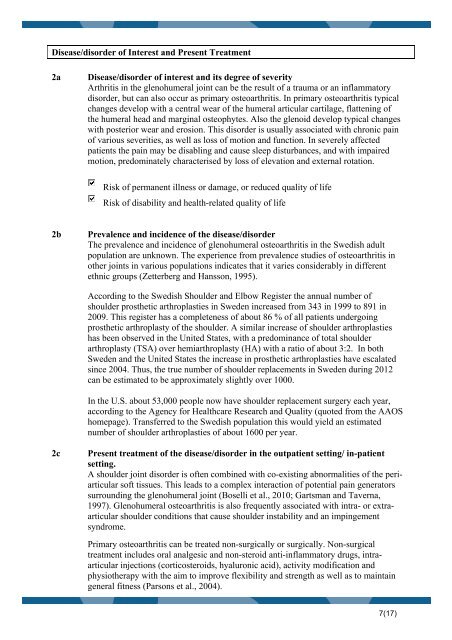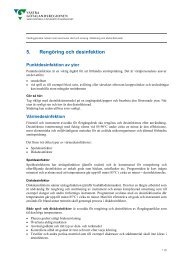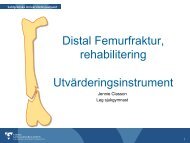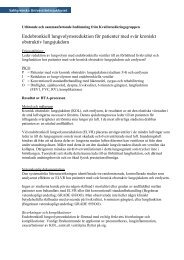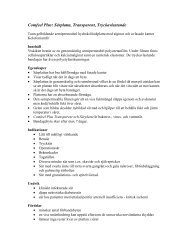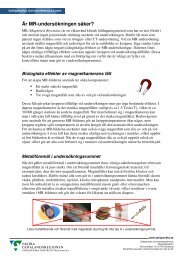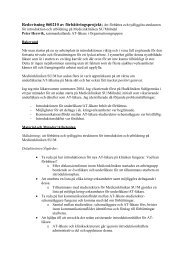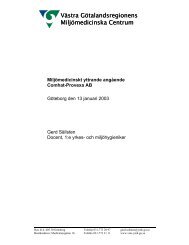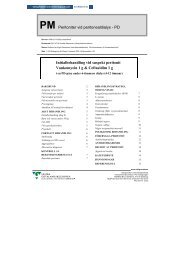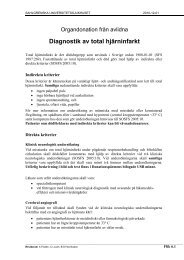HTA - Sahlgrenska Universitetssjukhuset
HTA - Sahlgrenska Universitetssjukhuset
HTA - Sahlgrenska Universitetssjukhuset
Create successful ePaper yourself
Turn your PDF publications into a flip-book with our unique Google optimized e-Paper software.
Disease/disorder of Interest and Present Treatment<br />
2a Disease/disorder of interest and its degree of severity<br />
Arthritis in the glenohumeral joint can be the result of a trauma or an inflammatory<br />
disorder, but can also occur as primary osteoarthritis. In primary osteoarthritis typical<br />
changes develop with a central wear of the humeral articular cartilage, flattening of<br />
the humeral head and marginal osteophytes. Also the glenoid develop typical changes<br />
with posterior wear and erosion. This disorder is usually associated with chronic pain<br />
of various severities, as well as loss of motion and function. In severely affected<br />
patients the pain may be disabling and cause sleep disturbances, and with impaired<br />
motion, predominately characterised by loss of elevation and external rotation.<br />
Risk of permanent illness or damage, or reduced quality of life<br />
Risk of disability and health-related quality of life<br />
2b Prevalence and incidence of the disease/disorder<br />
The prevalence and incidence of glenohumeral osteoarthritis in the Swedish adult<br />
population are unknown. The experience from prevalence studies of osteoarthritis in<br />
other joints in various populations indicates that it varies considerably in different<br />
ethnic groups (Zetterberg and Hansson, 1995).<br />
According to the Swedish Shoulder and Elbow Register the annual number of<br />
shoulder prosthetic arthroplasties in Sweden increased from 343 in 1999 to 891 in<br />
2009. This register has a completeness of about 86 % of all patients undergoing<br />
prosthetic arthroplasty of the shoulder. A similar increase of shoulder arthroplasties<br />
has been observed in the United States, with a predominance of total shoulder<br />
arthroplasty (TSA) over hemiarthroplasty (HA) with a ratio of about 3:2. In both<br />
Sweden and the United States the increase in prosthetic arthroplasties have escalated<br />
since 2004. Thus, the true number of shoulder replacements in Sweden during 2012<br />
can be estimated to be approximately slightly over 1000.<br />
In the U.S. about 53,000 people now have shoulder replacement surgery each year,<br />
according to the Agency for Healthcare Research and Quality (quoted from the AAOS<br />
homepage). Transferred to the Swedish population this would yield an estimated<br />
number of shoulder arthroplasties of about 1600 per year.<br />
2c Present treatment of the disease/disorder in the outpatient setting/ in-patient<br />
setting.<br />
A shoulder joint disorder is often combined with co-existing abnormalities of the periarticular<br />
soft tissues. This leads to a complex interaction of potential pain generators<br />
surrounding the glenohumeral joint (Boselli et al., 2010; Gartsman and Taverna,<br />
1997). Glenohumeral osteoarthritis is also frequently associated with intra- or extraarticular<br />
shoulder conditions that cause shoulder instability and an impingement<br />
syndrome.<br />
Primary osteoarthritis can be treated non-surgically or surgically. Non-surgical<br />
treatment includes oral analgesic and non-steroid anti-inflammatory drugs, intraarticular<br />
injections (corticosteroids, hyaluronic acid), activity modification and<br />
physiotherapy with the aim to improve flexibility and strength as well as to maintain<br />
general fitness (Parsons et al., 2004).<br />
7(17)


